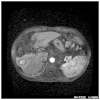Acquired amegakaryocytic thrombocytopenic purpura induced by percutaneous ethanol injection during treatment of hepatocellular carcinoma: A case report
- PMID: 26870287
- PMCID: PMC4727072
- DOI: 10.3892/ol.2015.3934
Acquired amegakaryocytic thrombocytopenic purpura induced by percutaneous ethanol injection during treatment of hepatocellular carcinoma: A case report
Abstract
Percutaneous ethanol injection is an important localized treatment method for patients presenting with hepatocellular carcinoma (HCC). Among the advantages of percutaneous ethanol injection are its minimal invasiveness, simplicity, low cost and low risk of complications. However, the increasing popularity of percutaneous ethanol injection has resulted in serious adverse effects attributed to individual variations. The present study describes the case of a patient who exhibited acquired amegakaryocytic thrombocytopenic purpura, caused by percutaneous ethanol injection treatment for HCC. This complication was promptly identified, and platelet transfusion and injection of recombinant human interleukin-11 resulted in a rapid recovery of the patient's platelet count. Attention should be given to this rare complication in patients administered percutaneous ethanol injection treatment for HCC.
Keywords: acquired amegakaryocytic thrombocytopenic purpura; complication; hepatocellular carcinoma; percutaneous ethanol injection.
Figures


Similar articles
-
Danazol in acquired amegakaryocytic thrombocytopenic purpura: a case report.Blut. 1985 Dec;51(6):401-4. doi: 10.1007/BF00320726. Blut. 1985. PMID: 3852685
-
Treatment of acquired amegakaryocytic thrombocytopenic purpura with cyclophosphamide.Am J Med. 1986 Jul;81(1):139-42. doi: 10.1016/0002-9343(86)90197-x. Am J Med. 1986. PMID: 3728540
-
Intraperitoneal hemorrhage as a major complication of percutaneous ethanol injection therapy for hepatocellular carcinoma.Hepatogastroenterology. 2000 Sep-Oct;47(35):1199-202. Hepatogastroenterology. 2000. PMID: 11100310
-
Rapid progression of acquired amegakaryocytic thrombocytopenia to aplastic anemia.South Med J. 1997 Jan;90(1):91-4. doi: 10.1097/00007611-199701000-00024. South Med J. 1997. PMID: 9003837 Review.
-
Nonsurgical treatment of hepatocellular carcinoma: from percutaneous ethanol injection therapy and percutaneous microwave coagulation therapy to radiofrequency ablation.Oncology. 2002;62 Suppl 1:64-8. doi: 10.1159/000048278. Oncology. 2002. PMID: 11868788 Review.
Cited by
-
Marked rebound thrombocytosis in response to glucocorticoids in a patient with acquired amegakaryocytic thrombocytopenia.J Clin Exp Hematop. 2018 Dec 13;58(4):166-170. doi: 10.3960/jslrt.18016. Epub 2018 Nov 9. J Clin Exp Hematop. 2018. PMID: 30416171 Free PMC article.
References
-
- Said A, Wells J. Management of hepatocellular carcinoma. Minerva Med. 2009;100:51–68. - PubMed
LinkOut - more resources
Full Text Sources
Other Literature Sources
